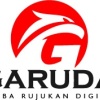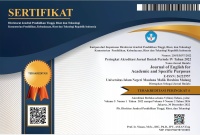EFL LEARNERS’ ABILITY IN USING DISCOURSE MARKERS TO BUILD COHERENCE IN THE WRITING
Abstract
Full Text:
PDFReferences
Adeyemi, B. (2018). Use of Discourse Markers in Writing and Answering Essay Questions among Undergraduates in Ondo State University of Science and Technology, Okitipupa, Nigeria. International Journal of Learning, Teaching and Educational Research, 17(7), 106-119.
Altenberg, B., & Tapper, M. (1998). The Use of Adverbial Connectors in Advanced Swedich Learners’ Written English. In S. Granger (Ed.), Learner English on Computer (pp. 80-93). New York: Longman.
Biber, D., & Finegan, E. 1998. Adverbial Stance Types in Englosh. Discourse Processes, 11(1), 1-34.
Blakemore, D. (2002). Relevance and Linguistic Meaning. The Semantics and Pragmatics of Discourse Markers. Cambridge: Cambridge University Press.
Bolton, K., Nelson, G., & Hung, J. (2002). A Corpus-based Study of Connectors in Student Writing. Research from the International Corpus of English in Hong Kong (ICE-HK). International Journal of Corpus Linguistics, 7(2), 165-182.
Brown, H.D. (2000). Teaching by Principles. An Interactive Approach to Language Pedagogy. 2nd Edition. London: Longman.
Carter, R & Fung, L. (2007). Discourse Markers and Spoken English: Native and Learner Use in Pedagogic Settings. Applied Linguistics, 28, 410-439.
Cho, Y. (1998). Use of Connectives in Writings by Korean Learners of English. (Report No. ED441348).
Chaudron, C & Richards, J. C. (1986). The Effect of Discourse Markers on the Comprehension of Lectures. Applied Linguistics, 7(2), 113-127.
Daifallah, D.A & Albesher, K. (2013). The Use of Discourse Markers in Paragraph Writings: The Case of Preparatory Year Program Students in Qasim University. Canadian Center of Science and Education, 6(9).
Fraser, B. (1990). An Approach to Discourse Markers. Journal of Pragmatics, 14, 383-95.
Fraser, B. (1999). What Are Discourse Markers? Journal of Pragmatics, 31(7), 931-952.
McCarthy, M. (1993). Discourse Analysis for Language Teachers. Cambridge: Cambridge University Press.
Mumbi, Cm,M & Simwinga, J. (2018). Challenges in the Use of Discourse Markers in English as Second Language (ESL) Writing: Evidence from Selected Grade Twelve Pupils in Kitwe District, Zambia. International Journal of Humanities and Cultural Studies, 5(2), 214-234.
Halliday, M.A.K. & Hasan, R. (1976). Cohesion in English. London: Longman.
Othman, Z. (2010). The use of okay, right and yeah in academic lectures by native speaker lectures. Discourse Studies, 12(5), 665-681.
Schiffrin, D. (1987). Discourse Markers. Cambridge: Cambridge University Press.
Swan, M. (2005). Practical English Usage. Oxford: Oxford University Press.
Walsh, S. (2006). Investigating classroom discourse. New York: Routledge.
Wuwuh, A. (2014). The use of English discourse markers in the argumentative writing of EFL Indonesian and Thai University students: A comparative study. Journal of Education, 7(1), 33-39.
DOI: https://doi.org/10.18860/jeasp.v2i1.7263
Refbacks
- There are currently no refbacks.





Editorial Office:
Pusat Pengembangan Bahasa
Program Khusus Pengembangan Bahasa Inggris (PKPBI)
Universitas Islam Negeri Maulana Malik Ibrahim Malang
Gedung C lantai 1
Jl. Gajayana No 50 Kota Malang, Jawa Timur, Indonesia
Kode Pos 65144, Telp/Fax : (0341) 570872
Email: jeasp@uin-malang.ac.id







